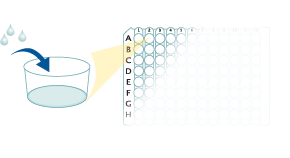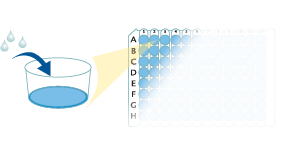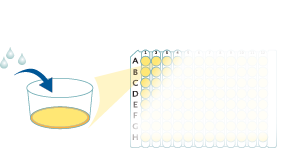 全部商品分类
全部商品分类


1/3

品牌: R&D Systems
 下载产品说明书
下载产品说明书 下载SDS
下载SDS 用小程序,查商品更便捷
用小程序,查商品更便捷


 收藏
收藏
 对比
对比 咨询
咨询
产品介绍
产品介绍
产品信息
产品详情
Product Summary
The Quantikine Mouse/Rat IGF-I Immunoassay is a 4.5 hour solid-phase ELISA designed to measure mouse and rat IGF-I in cell culture supernates, tissue homogenates, serum, and plasma. It contains E. coli-expressed recombinant mouse IGF-I and antibodies raised against the recombinant factor. This immunoassay has been shown to accurately quantitate the recombinant factor. Results obtained using natural mouse and rat IGF-I showed linear curves that were parallel to the standard curves obtained using the Quantikine kit standards. These results indicate that this kit can be used to determine relative mass values for naturally occurring mouse/rat IGF-I.
Recovery
The recovery of mouse/rat IGF-I spiked to three levels throughout the range of the assay in the cell culture supernate samples was evaluated.
| Sample Type | Average % Recovery | Range % |
|---|---|---|
| Mouse Cell Culture Supernates (n=7) | 98 | 89-111 |
| Rat Cell Culture Supernates (n=6) | 98 | 82-108 |
Linearity
To assess the linearity of the assay, samples containing mouse or rat IGF-I in each matrix were diluted with Calibrator Diluent and then assayed.
Scientific Data
Assay Procedure
Refer to the product Bring all reagents and samples to room temperature before use. It is recommended that all samples, standards, and controls be assayed in duplicate.
- Prepare all reagents, standard dilutions, and samples as directed in the product insert.
- Remove excess microplate strips from the plate frame, return them to the foil pouch containing the desiccant pack, and reseal.
- Add 50 µL of Assay Diluent to each well.
- Add 50 µL of Standard, Control, or sample to each well. Cover with a plate sealer, and incubate at room temperature for 2 hours on a horizontal orbital microplate shaker.
- Aspirate each well and wash, repeating the process 4 times for a total of 5 washes.
- Add 100 µL of Conjugate to each well. Cover with a new plate sealer, and incubate at room temperature for 2 hours on the shaker.
- Aspirate and wash 5 times.
- Add 100 µL Substrate Solution to each well. Incubate at room temperature for 30 minutes on the benchtop. PROTECT FROM LIGHT.
- Add 100 µL of Stop Solution to each well. Read at 450 nm within 30 minutes. Set wavelength correction to 540 nm or 570 nm.
50 µL Assay Diluent


50 µL Standard, Control, or Sample


100 µL Conjugate


100 µL Substrate Solution


100 µL Stop Solution


Mouse/Rat IGF-I/IGF-1 Quantikine ELISA Kit Summary
Assay Type
Solid Phase Sandwich ELISA
Format
96-well strip plate
Assay Length
4.5 hours
Sample Type & Volume Required Per Well
Cell Culture Supernates (25 uL), Tissue Homogenates (50 uL), Serum (10 uL), EDTA Plasma (10 uL), Heparin Plasma (10 uL)
Sensitivity
8.4 pg/mL
Assay Range
31.2 - 2,000 pg/mL (Cell Culture Supernates, Tissue Homogenates, Serum, EDTA Plasma, Heparin Plasma)
Specificity
Natural and recombinant mouse and rat IGF-I
Cross-reactivity
< 0.5% cross-reactivity observed with available related molecules.< 50% cross-species reactivity observed with species tested.
Interference
No significant interference observed with available related molecules.
背景
别名
IBP1,IGF1,IGF-1,IGF1A,IGFI,IGF-I,IGF-IA,IGF-IB,insulin-like growth factor 1 (somatomedin C),insulin-like growth factor 1,insulin-like growth factor I,insulin-like growth factor IA,insulin-like growth factor IB,Mechano growth factor,MGF,Somatomedin A,Somatomedin C,somatomedin-C,Insulin-like Growth Factor I/Insulin-like Growth Factor 1

背景
Background: IGF-I/IGF-1
Insulin-like Growth Factor 1 (IGF-1), also known as somatomedin C, is a member of the insulin superfamily. It was originally discovered as a mediator of growth hormone actions on somatic cell growth, but has also been shown to be an important regulator of cell metabolism, differentiation and survival. IGF-1 is synthesized as a preproprotein that is proteolytically cleaved to generate the mature protein linked by three disulfide bonds. Mature IGF-1 is highly conserved among large mammals, with 100% sequence identity between the human, bovine, porcine, equine, and canine proteins.
Mature mouse IGF-1 is a non-glycosylated, 70 amino acid (aa) secreted polypeptide that is derived from either a 153 aa or a 159 aa preproprotein. It shares 99% and 94% aa sequence identity with rat and human IGF-1, respectively. IGF-1 is synthesized in the liver and other tissues. It is found in blood and other body fluids as a complex with specific high affinity IGF binding proteins (IGFBP-1 to -6). The IGFBPs are expressed in specific patterns during development. They are modulators of IGF actions, which control IGF bioavailability to specific cell-surface receptors. Their functions are further regulated by IGFBP proteases, which proteolytically cleave the IGFBPs to lower the affinity with which they bind IGFs and increase IGF bioavailability. Some IGFBPs also have IGF-Independent effects on cell functions. IGF-Independent circulates primarily as a ternary complex with IGFBP-3 or IGFBP-5 and the acid-labile subunit (ALS). Some IGF-1 is also present in binary complexes with other IGFBPs. Whereas the ternary complexes are generally restricted to the vasculature, the binary complexes freely enter the tissues.
IGF-1 actions are mediated by two ubiquitously expressed receptor tyrosine kinases: IGF-I R and Insulin R/CD220. IGF-I R and Insulin R are disulfide-linked heterotetrameric complexes that consist of two alpha and two beta subunits. For both of these receptors, the prepro proteins are cleaved to produce extracellular alpha subunits which contain a cysteine-rich region and ligand-binding fibronectin type III (FN-III) domains, and beta subunits which contain an extracellular FN-III domain, transmembrane, and cytoplasmic tyrosine kinase domains. A hybrid complex containing one IGF-I R and one Insulin R also serves as a functional high affinity receptor for IGF-1. IGF-I R-Insulin R hybrids respond primarily to IGF-1, potentially downregulating the cellular response to Insulin. IGF signaling is also modulated by IGF binding proteins and the scavenger receptor, IGF-I I R.
Long Name:
Insulin-like Growth Factor I/Insulin-like Growth Factor 1
Entrez Gene IDs:
3479 (Human); 16000 (Mouse); 24482 (Rat)
Alternate Names:
IBP1; IGF1; IGF-1; IGF1A; IGFI; IGF-I; IGF-IA; IGF-IB; insulin-like growth factor 1 (somatomedin C); insulin-like growth factor 1; insulin-like growth factor I; insulin-like growth factor IA; insulin-like growth factor IB; Mechano growth factor; MGF; Somatomedin A; Somatomedin C; somatomedin-C

研究领域
制备和贮存
保存方式
Preparation and Storage
Shipping
The product is shipped at ambient temperature. Upon receipt, store it immediately at the temperature recommended below.
Storage
Store the unopened product at 2 - 8 °C. Do not use past expiration date.
声明 :本官网所有报价均为常温或者蓝冰运输价格,如有产品需要干冰运输,需另外加收干冰运输费。









